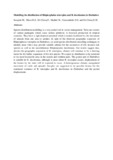Please use this identifier to cite or link to this item:
https://cris.library.msu.ac.zw//handle/11408/3444Full metadata record
| DC Field | Value | Language |
|---|---|---|
| dc.contributor.author | Sungirai, Marvelous | - |
| dc.contributor.author | Moyo, Doreen Zandile | - |
| dc.contributor.author | De Clercq, P. | - |
| dc.contributor.author | Madder, M. | - |
| dc.contributor.author | Vanwambeke, S.O. | - |
| dc.contributor.author | De Clercq, E. M. | - |
| dc.date.accessioned | 2019-02-11T07:40:20Z | - |
| dc.date.available | 2019-02-11T07:40:20Z | - |
| dc.date.issued | 2018 | - |
| dc.identifier.uri | https://www.sciencedirect.com/science/article/pii/S2405939018300856 | - |
| dc.identifier.uri | http://hdl.handle.net/11408/3444 | - |
| dc.description.abstract | Species distribution modelling is a very useful tool in vector management. Ticks are vectors of various pathogens which cause serious problems in livestock production in tropical countries. They have a high dispersal potential which is mainly facilitated by the movement of animals from one area to another. In light of the observed geographic expansion of Rhipicephalus microplus in Zimbabwe, we used species distribution modelling techniques to identify areas which may provide suitable habitats for the occurrence of this invasive tick species as well as the autochthonous Rhipicephalus decoloratus. Our results suggest that, despite the geographic expansion of R. microplus, climate will continue to be a limiting factor for the further expansion of this tick species. We expect its distribution to be restricted to the most favourable areas in the eastern and northern parts. The greater part of Zimbabwe is suitable for R. decoloratus, although in areas where R. microplus occurs, displacement of the former by the latter will be expected to occur. A heterogeneous climate, unregulated movement of cattle and episodic droughts are suggested to be possible factors for the continued existence of R. microplus and R. decoloratus in Zimbabwe and the partial displacement. | en_US |
| dc.language.iso | en | en_US |
| dc.publisher | Elsevier | en_US |
| dc.relation.ispartofseries | Veterinary Parasitology: Regional Studies and Reports;Vol. 14: p. 41-49 | - |
| dc.subject | Modelling | en_US |
| dc.subject | Habitat suitability | en_US |
| dc.subject | Zimbabwe | en_US |
| dc.title | Modelling the distribution of Rhipicephalus microplus and R. decoloratus in Zimbabwe | en_US |
| dc.type | Article | en_US |
| item.fulltext | With Fulltext | - |
| item.grantfulltext | open | - |
| item.openairetype | Article | - |
| item.cerifentitytype | Publications | - |
| item.languageiso639-1 | en | - |
| item.openairecristype | http://purl.org/coar/resource_type/c_18cf | - |
| Appears in Collections: | Research Papers | |
Files in This Item:
| File | Description | Size | Format | |
|---|---|---|---|---|
| Modelling the distribution of Rhipicephalus microplus and R.pdf | Abstract | 5.31 kB | Adobe PDF |  View/Open |
Page view(s)
150
checked on Nov 23, 2025
Download(s)
16
checked on Nov 23, 2025
Google ScholarTM
Check
Items in MSUIR are protected by copyright, with all rights reserved, unless otherwise indicated.



